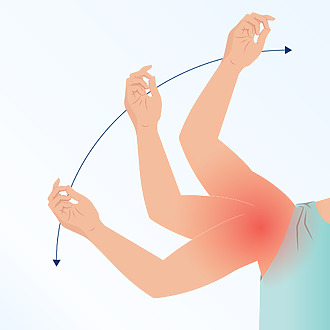Biomag - Encyclopedia - Frozen shoulder
Frozen shoulder - symptoms, description and treatment

Author MUDr. Peter Bednarčík CSc.
Revision

You know that feeling when your shoulder gets stiff and movement is difficult? You were probably experiencing frozen shoulder syndrome. It is a painful and limiting condition that affects many people. Symptoms can include pain in the shoulder, limited range of motion, and also stiffness in the shoulder. All of this has a significant impact on your daily life. This condition can occur gradually or suddenly and can last for months to years.
What are the treatment options for frozen shoulder and the symptoms that accompany this condition? Read more here.
Frozen shoulder symptoms
- Pain in the shoulder
- Limited mobility
- Pain in movement
- Stiffening of the shoulder
- Night pain
- Weakness in the shoulder
- Posture issues
Symptoms of frozen shoulder can vary. It is important to discuss the symptoms with your doctor, who will perform a physical examination and possibly other tests for frozen shoulder to make a correct diagnosis and suggest appropriate treatment. [1]

Only a doctor can make a correct diagnosis. Do not use this or any other article on the internet to make a diagnosis. Do not delay seeing a doctor and address your condition early.
Description and causes of frozen shoulder

Frozen shoulder – what is it?
Frozen shoulder (adhesive capsulitis) is an inflammatory disease of the shoulder joint that causes pain and limitation of movement. The disease progresses through three main stages:
Frozen shoulder stages:
- Freezing takes 2-9 months. Gradually, pain increases and limits movement.
- Frozen lasts 4-12 months. The pain is constant, and the restriction of movement is the greatest.
- Thawing takes 5-24 months. Pain and movement restrictions gradually improve.[2]
Frozen shoulder causes
The exact cause is not fully understood, but there are several factors that can contribute to its occurrence:
- Inflammation
Inflammation can lead to stiffening and shortening of the joint ligaments, which limits the movement in the shoulder. - Shoulder immobilization
Prolonged immobility due to injury or surgery can cause loss of flexibility of the joint capsule and ligaments. - Systemic diseases
It may be more common in people suffering from diseases such as diabetes, psoriasis and the like. - Shoulder injury or surgery
A frozen shoulder after surgery or injury is not unheard of. Both can lead to inflammation and stiffening of the joint capsule. - Autoimmune reactions
The immune system attacks its own tissues in the shoulder joint. - Psychological causes
For example, stress, depression, anxiety or strain.
How is frozen shoulder diagnosed?

It usually begins by consulting a physician who looks at the patient’s medical history, symptoms and physical examination or other tests.
- History and symptoms: the doctor will ask about symptoms, when they appeared and how they develop. They may also ask about past injuries to the shoulder, medical conditions and medications the patient is taking.
- Physical examination: the doctor carefully examines and palpates the shoulder to see if there is any swelling or stiffness.
- Passive and active movement tests of the frozen shoulder: The aim is to assess the range of motion of the affected shoulder.
- Imaging tests: sometimes your doctor may recommend imaging tests such as X-rays, magnetic resonance imaging (MRI) or ultrasound to rule out other possible causes of shoulder pain, such as arthritis, fractures or tendon and muscle damage. [3]
Did you know?
- It affects up to 2-5% of the population [4]
Complications when left untreated
If it is not treated, or the treatment is not effective, complications can occur with a significant impact on your life.
- An untreated stiff shoulder can lead to work disability and inability to carry out normal activities.
- Chronic pain can lead to other health problems such as insomnia, anxiety or depression.
- Long-term restriction of movement in the shoulder may lead to weakening and loss of muscle mass.
- Untreated may lead to posture issues. It can cause further pain or problems with the spine.
Work disability
Illness
Muscle weakness
Spine issues

We recommend not postponing treatment of frozen shoulder
Do not delay treatment for frozen shoulder, and if you have any health problems or doubts about your health, see a specialist. This will prevent unnecessary health complications.
Frozen shoulder treatment

Treatment focuses on relieving pain and improving range of motion and function of the shoulder joint. The sooner treatment begins, the quicker the recovery and the less likely disability or shorter duration of disability.
There are several treatment options. They can be used alone or in combination, depending on the needs of the patient:
- Your doctor may prescribe analgesics, such as non-steroidal anti-inflammatory drugs (NSAIDs) or paracetamol, to relieve pain and inflammation.
- Physical therapy is an essential component of its treatment. The physical therapist will work with the patient to develop an individualized exercise program that focuses on improving range of motion, strengthening muscles and improving joint stability.
- Injections of corticosteroids may be used to reduce inflammation and pain in the shoulder joint. The injections usually provide quick pain relief and can improve range of motion. Their effect is often temporary.
- Hot and cold compresses can help relieve pain and inflammation. Heat increases blood flow and can relax stiff muscles, while cold compresses reduce swelling and inflammation
- Transcutaneous electrical nerve stimulation (TENS) is a non-invasive method that uses electrical impulses to affect the nerve signals that cause pain.
- Ultrasound therapy is a non-invasive method that uses sound waves. These sound waves can help improve blood flow to the affected area, which can help relieve pain and accelerate healing.
- In some cases, manipulation of the joint under anaesthesia may be indicated. This procedure involves the physician moving the patient’s shoulder while under anaesthesia to loosen stiff tissues and improve range of motion.
- Surgery is used in extreme cases.[5]

Beware
Treatment for frozen shoulder can only be determined by your doctor after considering your overall health. Therefore, do not use this article as a guide for treatment, as this can only be determined by a doctor.
Prevention of frozen shoulder
Prevention usually focuses on maintaining good flexibility and strength in the shoulder joint.
- Regular exercise helps to maintain the flexibility and strength of the shoulder joint.
- Warm up the shoulder with dynamic exercises before starting physical activity.
- If you tend to sleep on your side, use a pillow to relieve tension in the shoulder.
- Use your legs, not your arms, when lifting heavy objects.
- Limit activities that can lead to shoulder strain, such as repetitive movements at the shoulder joint.
- Although swimming can be beneficial, it is important to consult a doctor.
- Proper nutrition can help reduce inflammation, promote tissue healing and improve overall health.
Frozen shoulder exercises

Exercises for frozen shoulders can help restore range of motion, reduce pain and improve shoulder function. It is important to consult with your doctor or physiotherapist before starting exercises. He or she will assess your situation and recommend an appropriate exercise program.
You can also do exercises at home. During the exercise, you should proceed with caution and stop if you feel severe pain.
Exercise for Frozen Shoulder at Home:
- Pendulum stretch: Stand up straight next to a table or chair and rest your good arm on the support. Let the affected arm hang loosely by your body and relax the shoulder. Use pendulum movements to gradually gain a greater range of motion.
- Cross-body reach: stand up straight, raise the affected arm to shoulder level and place it across the body. With the other hand, grasp the forearm of the affected arm and gently pull it towards the opposite shoulder. Maintain the stretch for 15-30 seconds and repeat 3-5 times on each side.
- Wall crawl: Stand close to the wall with the affected shoulder closer to the wall. Place the fingertips of the affected hand on the wall at shoulder level and slowly crawl upwards. Once you have reached your maximum range of motion, stay in this position for a few seconds and then return to the starting position.
- Towel stretch: hold the towel or strap by both ends, with one hand above your head and the other behind your back. With the affected hand behind your back, slowly pull the towel up while holding it firmly with the other hand above your head. Hold the stretch for 15-30 seconds and repeat 3-5 times on each side. [6]
Taping frozen shoulder
Taping a frozen shoulder can help reduce pain and improve joint mobility. Consultation with a specialist such as a physiotherapist is always advisable. He or she will show you the correct taping techniques. Here are just basic recommendations:
- Choose a quality, flexible and hypoallergenic kinesiology tape that provides a good grip but does not cause skin irritation.
- Clean and dry the affected area before taping.
- Before using the tape, warm it by rubbing it between the palms of your hands, which will improve adhesion.
- Apply the tape according to the instructions of your physiotherapist or other professional.
- If you want to use online resources for your application, use trusted ones: https://www.youtube.com/watch?v=v7t5IP33JIQ
Frozen shoulder and nutrition
Nutritionists can recommend these tips in the prevention:
- Omega-3 fatty acids: Found in fish oil, flaxseeds, nuts and chia seeds.
- Vitamin C: It is important for the formation of collagen, which is an essential component of connective tissue. For example, oranges, kiwis, strawberries, peppers and broccoli.
- Proteins: Are essential for tissue repair and regeneration. Good sources of protein include lean meat, poultry, fish, eggs, dairy products or legumes.
- Zinc: It is important for wound healing and immune system health. Sources include beef, poultry, pork, legumes, whole grains and nuts.
- Antioxidants: these are vitamins A, C and E, and the mineral selenium. They can help protect the body from damage caused by free radicals and reduce inflammation. Fruits, vegetables, nuts and seeds are rich in antioxidants.
- Fibre: Include whole grains, fruits, vegetables, legumes and nuts in your diet.
- Hydration: drink enough water. Water is important for maintaining joint health and connective tissue elasticity.
Home remedies for frozen shoulder
Home remedies can sometimes be useful. It is important to remember that they are not always based on scientific evidence and may not be effective for everyone. It is also important to stress that it is best to follow the advice of your doctor or physiotherapist when treating frozen shoulder. However, here are some home remedies that can be used:
- Herbal ointments and balms with anti-inflammatory and analgesic effects can be tried.
- Gentle massages can help relax muscles and improve joint mobility.
- Applying warm or cold compresses to the affected shoulder can help relieve pain and stiffness in some individuals.

Important information when dealing with a frozen shoulder
Avoid overloading the shoulder. Take time to relax. Overexertion can renew your frozen shoulder problems.
Frozen shoulder and degree of disability
If your experience of frozen shoulder is severe and long-lasting, and it prevents you from working fully, you can try to claim disability. The appropriate panel will assess your disability and ability to work. Based on this assessment, you may be awarded a degree of disability and be entitled to disability benefits.
Summary and recommendations for dealing with frozen shoulder
See your physician
Treatment for frozen shoulder is always determined by your doctor based on a general examination, an assessment of your condition and an accurate diagnosis.
Causal treatment of frozen shoulder
After a general examination, your doctor will recommend treatment for the cause of your frozen shoulder. In connection with this, he will also recommend possible lifestyle modification and further course of action to deal with it.
Relieving pain, inflammation and accelerating healing
Symptomatic treatment focuses on the manifestations or symptoms of the disease. Such treatment can significantly improve your quality of life and support comprehensive treatment as the disease progresses.
Sources, references and literature
1. Frozen shoulder, NHS inform; March 2023. Available at: https://www.nhsinform.scot/illnesses-and-conditions/muscle-bone-and-joints/conditions/frozen-shoulder
2. Physical therapy in the management of frozen shoulder, Singapore Med.J; December 2023. Available at: https://www.ncbi.nlm.nih.gov/pmc/articles/PMC5917053/
3. Diagnosing Frozen Shoulder, Pietro Tonino, MD:Veritas Health, LLC:September 2016. Available at: https://www.ncbi.nlm.nih.gov/pmc/articles/PMC5917053/
4. Frozen Shoulder:Overview,:National Library of Medicine :September 2008. Available at: https://www.ncbi.nlm.nih.gov/books/NBK326432/
5. Frozen Shoulder, Cleveland Clinic:January 2019. Available at: https://www.ncbi.nlm.nih.gov/pmc/articles/PMC5917053/
6. 7 stretching & strengthening exercises for a frozen shoulder, Harvard Health Publishing:August 2020. Available at:https://www.health.harvard.edu/shoulders/stretching-exercises-frozen-shoulder
| Rate this article |
|
|
5/52 Reviewed by
|
How to Control Pain, Inflammation and Accelerate Healing?
The solution may be symptomatic treatment using pulsed magnetic therapy (PEMF therapy), which targets symptoms and signs such as pain and inflammation. In addition, such treatment can support comprehensive treatment and significantly improve quality of life.
Explaining the Effects
The basic principle of Biomag 3D pulsed magnetic therapy (PEMF therapy) is the generation of electromagnetic pulses. These pulses penetrate through clothing and through the entire depth of the tissue to the point of targeted application. The pulses have specially developed biotropic parameters (e.g. frequency, shape, intensity) to best affect various health problems.
What are the effects of 3D magnetic therapy (PEMF therapy)?
- Helps relieve pain.
- Mitigates inflammation.
- Suppresses swelling.
How is the treatment applied?
The application is very simple. You select the desired therapeutic effect on the device and attach the supplied applicator to the desired application site. Magnetic therapy is usually applied 2 times a day for 20 minutes.
We will be happy to help you try this method and advise you on which device to purchase.






